lock ASTON MARTIN DB7 1997 Owner's Guide
[x] Cancel search | Manufacturer: ASTON MARTIN, Model Year: 1997, Model line: DB7, Model: ASTON MARTIN DB7 1997Pages: 421, PDF Size: 9.31 MB
Page 217 of 421
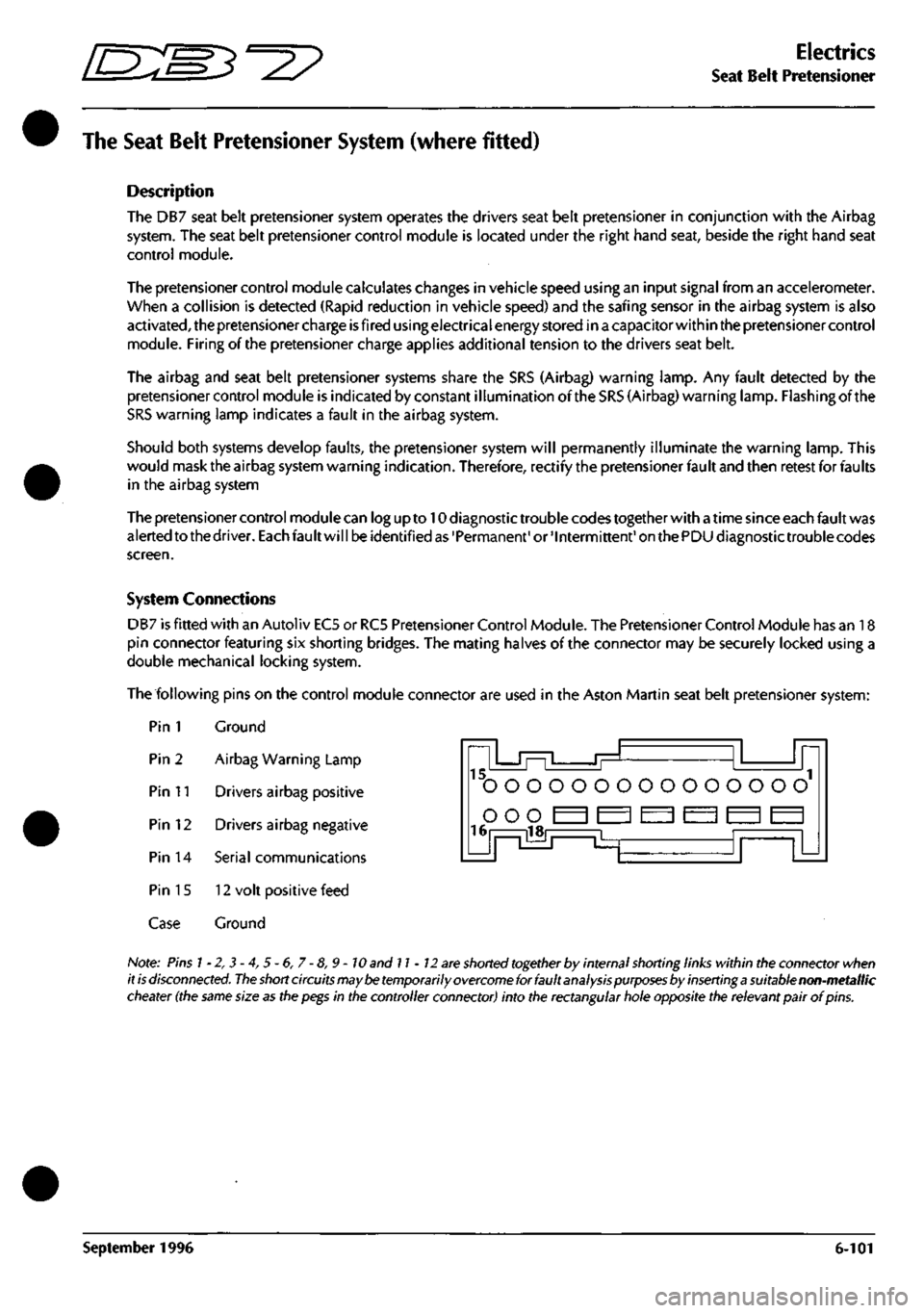
5^^?
Electrics
Seat Belt Pretensioner
The Seat Belt Pretensioner System (where fitted)
Description
The DB7 seat belt pretensioner system operates the drivers seat belt pretensioner in conjunction with the Airbag
system.
The seat belt pretensioner control module is located under the right hand seat, beside the right hand seat
control module.
The pretensioner control module calculates changes in vehicle speed using an input signal from an accelerometer.
When a collision is detected (Rapid reduction in vehicle speed) and the safing sensor in the airbag system is also
activated,
the pretensioner charge
is
fi red usingelectrical energy stored in a capacitor within the pretensioner control
module. Firing of the pretensioner charge applies additional tension to the drivers seat belt.
The airbag and seat belt pretensioner systems share the SRS (Airbag) warning lamp. Any fault detected by the
pretensioner control module is indicated by constant illumination ofthe
SRS
(Airbag) warning lamp. Flashing of the
SRS warning lamp indicates a fault in the airbag system.
Should both systems develop faults, the pretensioner system will permanently illuminate the warning lamp. This
would mask the airbag system warning indication. Therefore, rectify the pretensioner fault and then retest for faults
in the airbag system
The pretensioner control module can log up to 10 diagnostic trouble codes together with a time since each fault was
alerted to the driver. Each
fau It
wi
11
be identified as 'Permanent' or 'Intermittent' on the PDU diagnostic trouble codes
screen.
System Connections
DB7 is fitted with an Autoliv ECS or RC5 Pretensioner Control Module. The Pretensioner Control Module has an 18
pin connector featuring six shorting bridges. The mating halves of the connector may be securely locked using a
double mechanical locking system.
The following pins on the control module connector are used in the Aston Martin seat belt pretensioner system:
Pin 1 Ground
' ' "L Pin 2 Airbag Warning Lamp
Pin 11 Drivers airbag positive
Pin 12 Drivers airbag negative
Pin 14 Serial communications
Pin 15 12 volt positive feed
Case Ground
15.
rrj ^
ooooooooooooooo
16 illn
^
Note: Pins
1
-2, 3 -4, 5 -6, 7 -8,9 -
10
and 11-12
are
shorted
together
by internal shorting links within the connector when
it
is
disconnected.
The
short circuits may
be
temporarily
overcome
for fault analysis
purposes
by inserting
a
suitable non-metallic
cheater
(the
sBfTiG
size
3s
the
p€gs
in the controller connector) into the rectsngul^r hole opposite the relevsnt p3ir of pins.
September 1996 6-101
Page 219 of 421
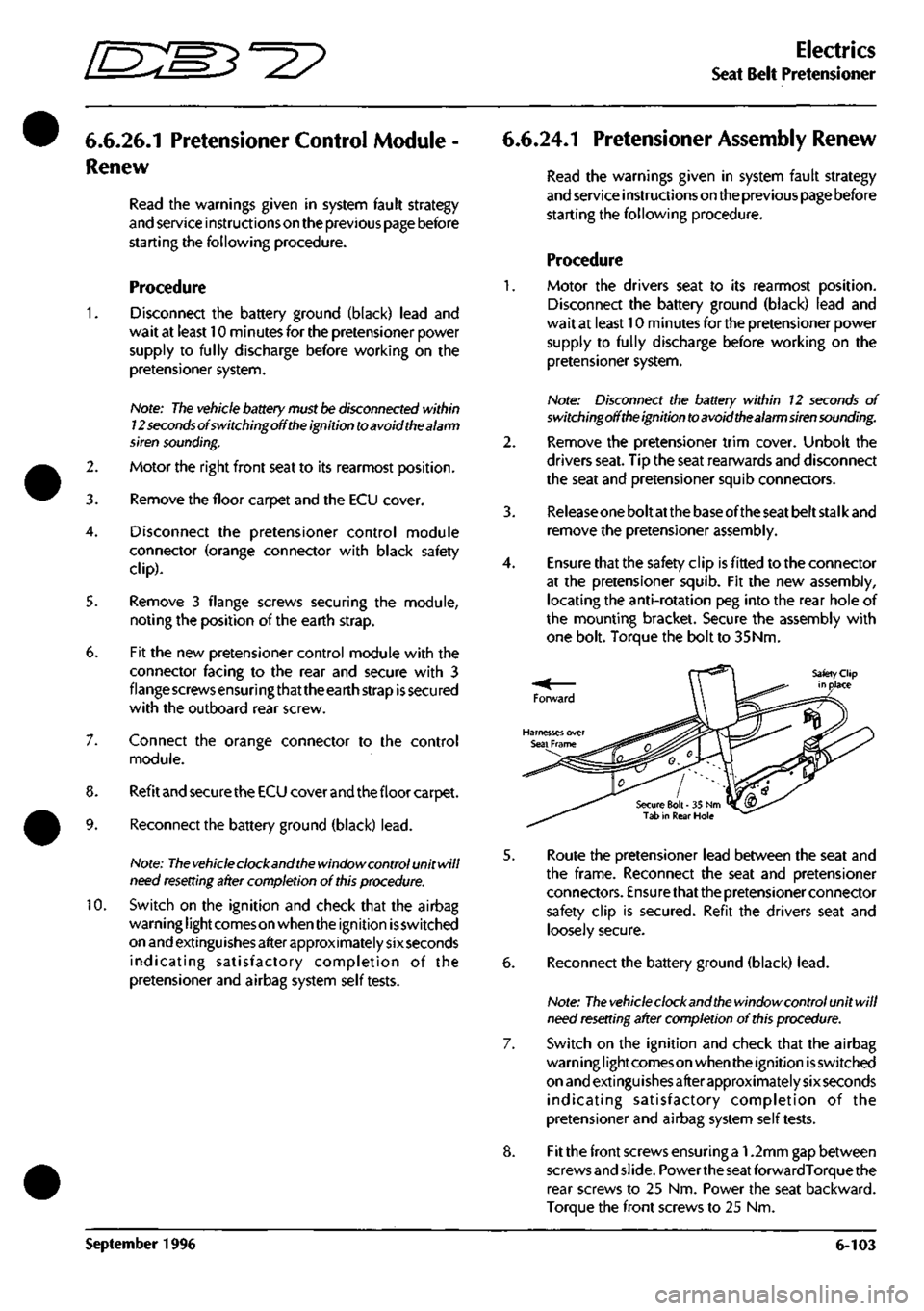
'^^
Electrics
Seat Belt Pretensioner
6.6.26.1
Pretensioner Control Module -
Renew
Read the warnings given in system fault strategy
and service instructions on the previous page before
starting the following procedure.
Procedure
1.
Disconnect the battery ground (black) lead and
wait at least 10 minutes for the pretensioner power
supply to fully discharge before working on the
pretensioner system.
Note:
The
vehicle battery must
be
disconnected within
12
seconds
of switching off
the
ignition to avoid the alarm
siren sounding.
2. Motor the right front seat to its rearmost position.
3. Remove the floor carpet and the ECU cover.
4.
Disconnect the pretensioner control module
connector (orange connector with black safety
clip).
5. Remove 3 flange screws securing the module,
noting the position of the earth strap.
6. Fit the new pretensioner control module with the
connector facing to the rear and secure with 3
flange screwsensuringthatthe earth strap is secured
with the outboard rear screw.
7. Connect the orange connector to the control
module.
8. RefitandsecuretheECU cover and the floor carpet.
9. Reconnect the battery ground (black)
lead.
Note:
The
vehicle clock and the window control unit will
need
resetting
after completion of this procedure.
10.
Switch on the ignition and check that the airbag
warni ng I ight comes on when the ign ition
is
switched
on and extinguishesafterapproximately sixseconds
indicating satisfactory completion of the
pretensioner and airbag system self tests.
6.6.24.1
Pretensioner Assembly Renew
Read the warnings given in system fault strategy
and service i nstruaions on the previous page before
starting the following procedure.
1.
2.
4.
Procedure
Motor the drivers seat to its rearmost position.
Disconnect the battery ground (black) lead and
wait at least 10 minutes for the pretensioner power
supply to fully discharge before working on the
pretensioner system.
Note: Disconnect the battery within 12 seconds of
switchingoffthe ignition to avoid the alarm siren sounding.
Remove the pretensioner trim cover. Unbolt the
drivers seat. Tip the seat rearwards and disconnect
the seat and pretensioner squib connectors.
Release one bolt at the
base
of the seat belt
stal k
and
remove the pretensioner assembly.
Ensure that the safety clip is fitted to the connector
at the pretensioner squib. Fit the new assembly,
locating the anti-rotation peg into the rear hole of
the mounting bracket. Secure the assembly with
one bolt. Torque the bolt to 35Nm.
Safety Clip in place
5. Route the pretensioner lead between the seat and
the frame. Reconnect the seat and pretensioner
connectors. Ensure that the pretensioner connector
safety clip is secured. Refit the drivers seat and
loosely secure.
6. Reconnect the battery ground (black)
lead.
Note:
The
vehicle clock and
the
window control unit will
need
resetting
after completion of this procedure.
7. Switch on the ignition and check that the airbag
warn i ng I ight comes on when the ignition
is
switched
on and extingu
ishes
after approximately six seconds
indicating satisfactory completion of the
pretensioner and airbag system self tests.
8. Fit the front screws ensuring a 1.2mm gap between
screws and slide. Power the seat forwardTorque the
rear screws to 25 Nm. Power the seat backward.
Torque the front screws to 25 Nm.
September 1996 6-103
Page 227 of 421
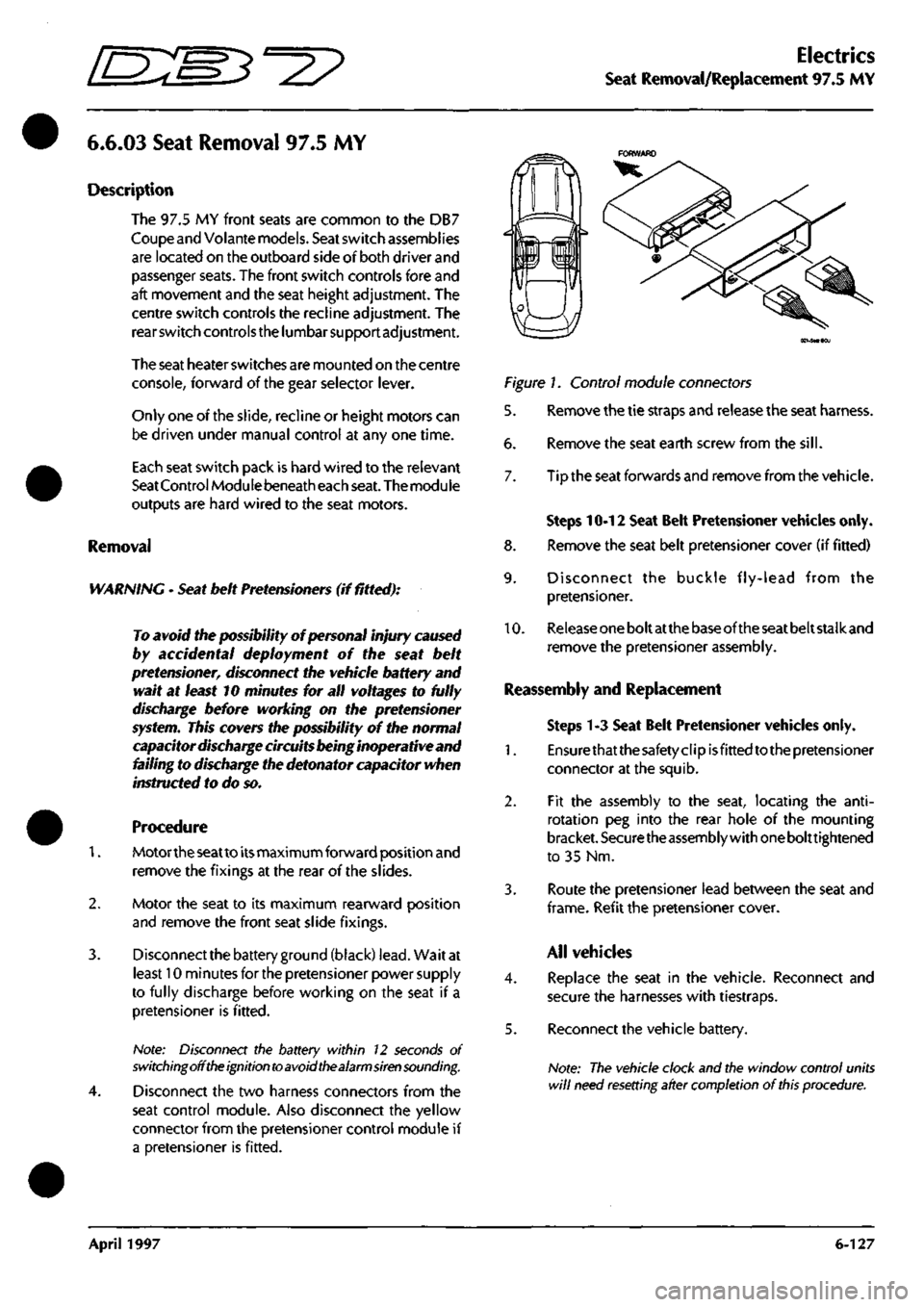
3-^?
Electrics
Seat Removal/Replacement 97.5 MY
6.6.03
Seat Removal 97.5 MY
Description
The 97.5 MY front seats are common to the DB7
Coupe
and
Volante
models.
Seat
switch
assembi ies
are located on the outboard side of both driver and
passenger
seats.
The front switch controls fore and
aft movement and the seat height adjustment. The
centre switch controls the recline adjustment. The
rear switch
controls
the
lumbar support adjustment.
The seat
heater switches are mounted on the centre
console, forward of the gear selector
lever.
Only one of
the
slide,
recline or height motors can
be driven under manual control at any one time.
Each seat switch pack is hard wired to the relevant
Seat Control
Module
beneath each
seat.
The
module
outputs are hard wired to the seat motors.
Removal
WARNING -
Seat
belt
Pretensioners
(if fitted):
To avoid the possibility
of
personal
injury
caused
by accidental deployment of the seat belt
pretensioner,
disconnect
the
vehicle battery and
wait at
least
10
minutes
for all
voltages
to fully
discharge
before working on the
pretensioner
system.
This covers the possibility
of
the normal
capacitor
discharge
circuits being inoperative and
failing to discharge the detonator capacitor when
instructed
to
do
so.
Procedure
1.
Motortheseatto
its
maximum forward position and
remove the fixings at the rear of the slides.
2.
Motor the seat to its maximum rearward position
and remove the front seat slide fixings.
3. Disconnect the battery
ground
(black)
lead.
Wait at
least 10 minutes for the pretensioner power supply
to fully discharge before working on the seat if a
pretensioner is fitted.
Note: Disconnect the battery within 12 seconds of
switching off the ignition to avoid the alarm siren sounding.
4.
Disconnect the two harness connectors from the
seat control module. Also disconnect the yellow
connector from the pretensioner control module if
a pretensioner is fitted.
Figure 1. Control module connectors
5. Remove the tie straps and release the seat harness.
6. Remove the seat earth screw from the
sill.
7. Tip the seat forwards and remove from the vehicle.
Steps 10-12 Seat Belt Pretensioner vehicles only.
8. Remove the seat belt pretensioner cover (if fitted)
9. Disconnect the buckle fly-lead from the
pretensioner.
10.
Release
one
bolt at
the
base of the
seat
belt stalk and
remove the pretensioner assembly.
Reassembly and Replacement
Steps 1-3 Seat Belt Pretensioner vehicles only.
1.
Ensurethatthesafetyclipisfittedtothepretensioner
connector at the squib.
2.
Fit the assembly to the seat, locating the
anti-
rotation peg into the rear hole of the mounting
bracket.
Securethe
assembly with
one
bolttightened
to 35 Nm.
3. Route the pretensioner lead between the seat and
frame.
Refit the pretensioner
cover.
All vehicles
4.
Replace the seat in the vehicle. Reconnect and
secure the harnesses with tiestraps.
5. Reconnect the vehicle battery.
Note:
The vehicle clock and the window control units
will
need resetting after completion
of
this
procedure.
April 1997 6-127
Page 229 of 421
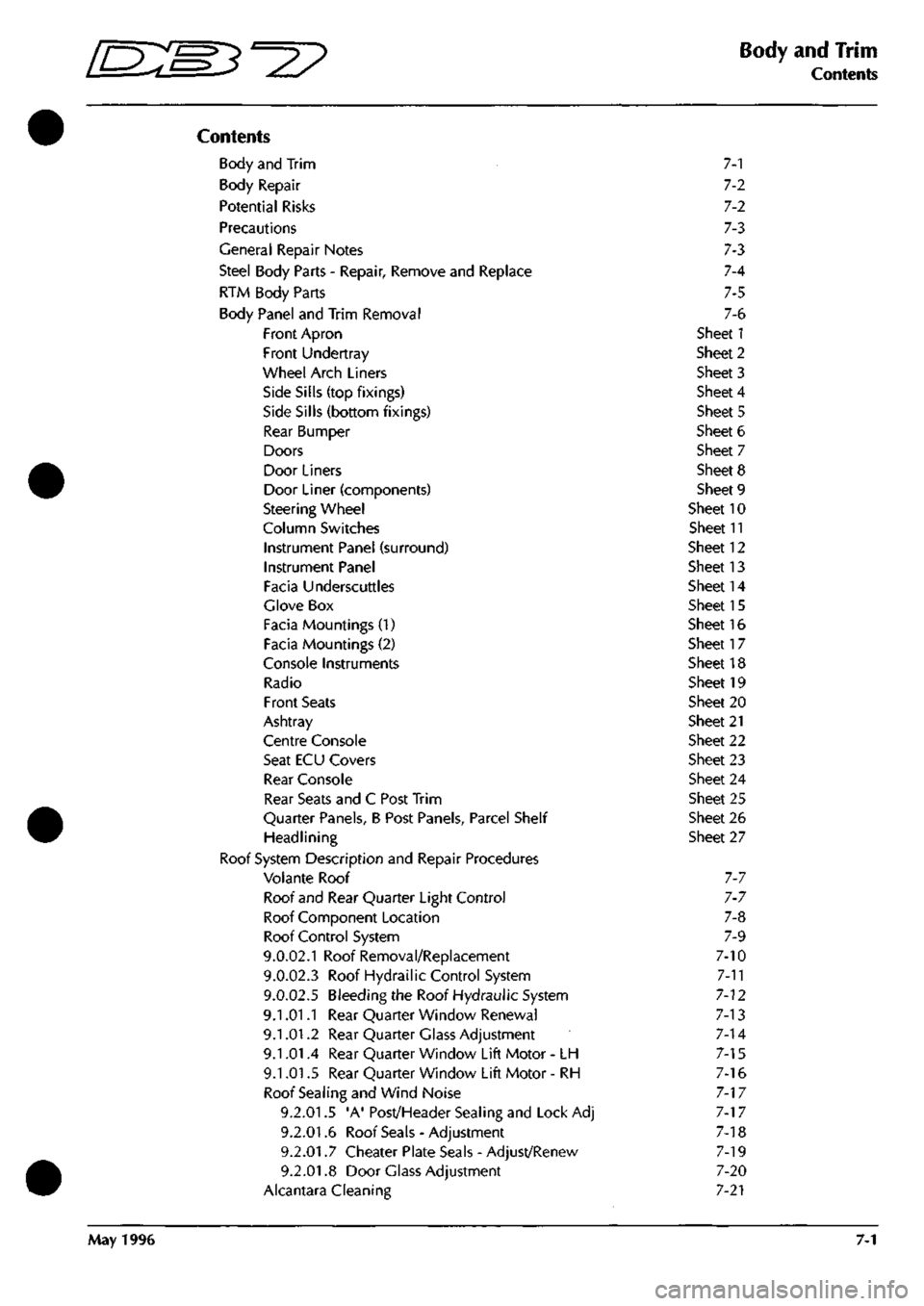
O" D^?
Body and Trim
Contents
Contents
Body and Trim
Body Repair
Potential Risks
Precautions
General Repair Notes
Steel Body Parts - Repair, Remove and Replace
RTM Body Parts
Body Panel and Trim Removal
Front Apron
Front Undertray
Wheel Arch Liners
Side Sills (top fixings)
Side Sills (bottom fixings)
Rear Bumper
Doors
Door Liners
Door Liner (components)
Steering Wheel
Column Switches
Instrument Panel (surround)
Instrument Panel
Facia Underscuttles
Glove Box
Facia Mountings (1)
Facia Mountings (2)
Console Instruments
Radio
Front Seats
Ashtray
Centre Console
Seat ECU Covers
Rear Console
Rear Seats and C Post Trim
Quarter Panels, B Post Panels, Parcel Shelf
Headlining
Roof System Description and Repair Procedures
Vol ante Roof
Roof and Rear Quarter Light Control
Roof Component Location
Roof Control System
9.0.02.1
Roof Removal/Replacement
9.0.02.3
Roof Hydrailic Control System
9.0.02.5
Bleeding the Roof Hydraulic System
9.1.01.1
Rear Quarter Window Renewal
9.1.01.2
Rear Quarter Glass Adjustment
9.1.01.4
Rear Quarter Window Lift Motor - LH
9.1.01.5
Rear Quarter Window Lift Motor - RH
Roof Sealing and Wind Noise
9.2.01.5
'A' Post/Header Sealing and Lock Adj
9.2.01.6
Roof Seals - Adjustment
9.2.01.7
Cheater Plate Seals - Adjust/Renew
9.2.01.8
Door Glass Adjustment
Alcantara Cleaning
7-1
7-2
7-2
7-3
7-3
7-4
7-5
7-6
Sheet 1
Sheet 2
Sheet 3
Sheet 4
Sheet 5
Sheet 6
Sheet 7
Sheet 8
Sheet 9
Sheet 10
Sheet 11
Sheet 12
Sheet 13
Sheet 14
Sheet 15
Sheet 16
Sheet 17
Sheet 18
Sheet 19
Sheet 20
Sheet 21
Sheet 22
Sheet 23
Sheet 24
Sheet 25
Sheet 26
Sheet 27
7-7
7-7
7-8
7-9
7-10
7-11
7-12
7-13
7-14
7-15
7-16
7-17
7-17
7-18
7-19
7-20
7-21
May 1996 7-1
Page 268 of 421
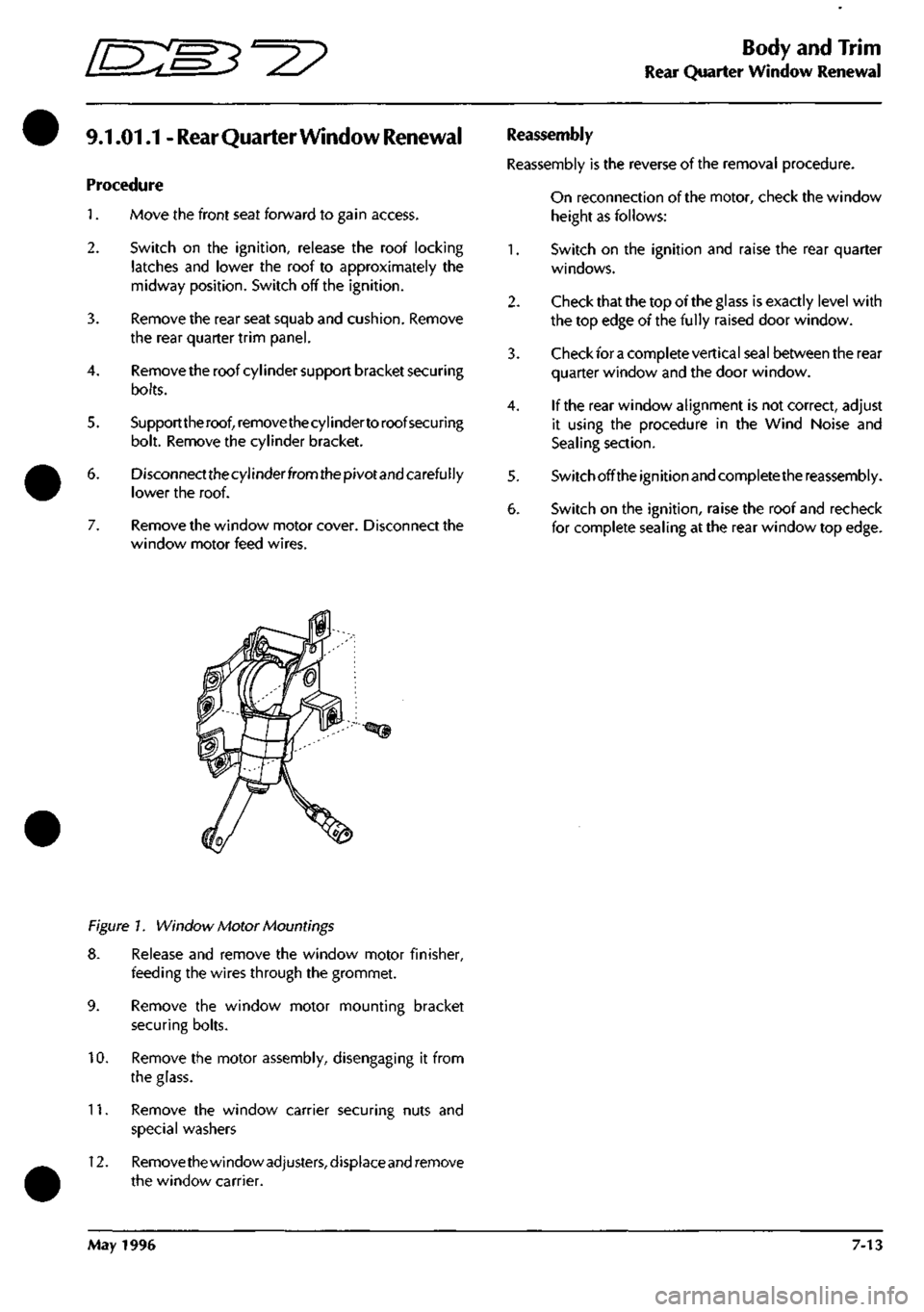
•=2?
Body and Trim
Rear Quarter Window Renewal
9.1.01.1 -
Rear
Quarter Window Renewal
Procedure
1.
Move the front seat forward to gain access.
2.
Switch on the ignition, release the roof locking
latches and lower the roof to approximately the
midway position. Switch off the ignition.
3. Remove the rear seat squab and cushion. Remove
the rear quarter trim panel.
4.
Remove the roof cylinder support bracket securing
bolts.
5. Support the roof, removethecylindertoroofsecuring
bolt. Remove the cylinder bracket.
6. Disconnectthecylinderfromthepivotand carefully
lower the roof.
7. Remove the window motor cover. Disconnect the
window motor feed wires.
Reassembly
Reassembly is the reverse of the removal procedure.
On reconnection of the motor, check the window
height as follows:
1.
Switch on the ignition and raise the rear quarter
windows.
2.
Check that the top of the glass is exactly level with
the top edge of the fully raised door window.
3. Check for
a
complete vertical seal between the rear
quarter window and the door window.
4.
If the rear window alignment is not correct, adjust
it using the procedure in the Wind Noise and
Sealing section.
5. Switch off the ignition and complete the reassembly.
6. Switch on the ignition, raise the roof and recheck
for complete sealing at the rear window top edge.
Figure 1. Window Motor Mountings
8. Release and remove the window motor finisher,
feeding the wires through the grommet.
9. Remove the window motor mounting bracket
securing bolts.
10.
Remove the motor assembly, disengaging it from
the glass.
11.
Remove the window carrier securing nuts and
special washers
12.
Remove the window
adjusters,
d isplace and remove
the window carrier.
May 1996 7-13
Page 269 of 421
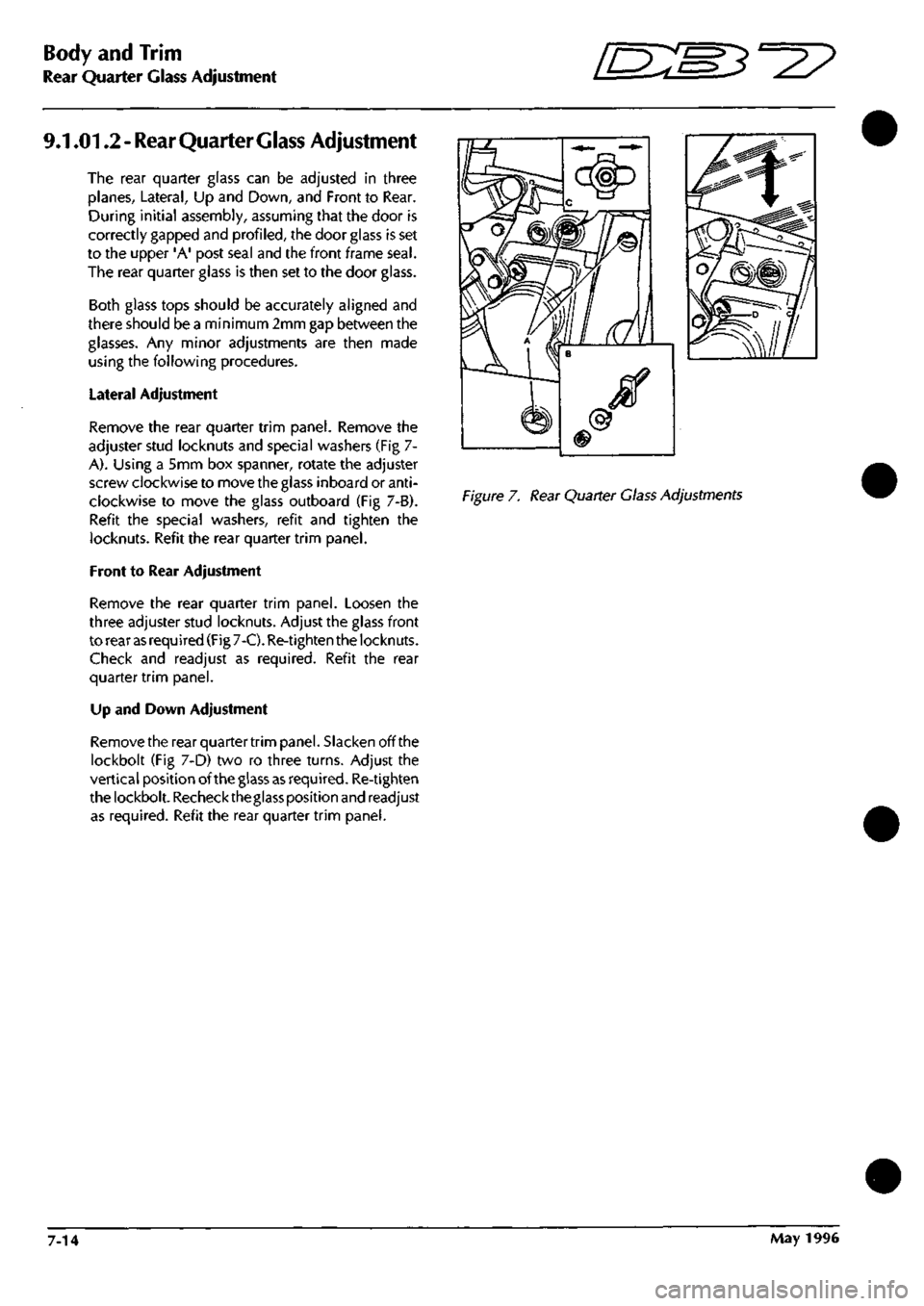
Body and Trim
Rear Quarter Glass Adjustment "^^
9.1.01.2
-
Rear Quarter Glass Adjustment
The rear quarter glass can be adjusted in three
planes, Lateral, Up and Down, and Front to Rear.
During initial assembly, assuming that the door is
correctly gapped and profiled, the door glass is set
to the upper 'A' post seal and the front frame
seal.
The rear quarter glass is then set to the door glass.
Both glass tops should be accurately aligned and
there should be a minimum 2mm gap between the
glasses. Any minor adjustments are then made
using the following procedures.
Lateral Adjustment
Remove the rear quarter trim panel. Remove the
adjuster stud locknuts and special washers (Fig 7-
A).
Using a 5mm box spanner, rotate the adjuster
screw clockwise to move the glass inboard or
anti
clockwise to move the glass outboard (Fig 7-B).
Refit the special washers, refit and tighten the
locknuts. Refit the rear quarter trim panel.
Front to Rear Adjustment
Remove the rear quarter trim panel. Loosen the
three adjuster stud locknuts. Adjust the glass front
to rear
as
required (Fig 7-C). Re-tighten the locknuts.
Check and readjust as required. Refit the rear
quarter trim panel.
Up and Down Adjustment
Remove the rear quarter trim panel. Slacken off the
lockbolt (Fig 7-D) two ro three turns. Adjust the
vertical position of the glass
as
required. Re-tighten
the lockbolt. Rechecktheglass position and readjust
as required. Refit the rear quarter trim panel.
Figure 7. Rear Quarter Class Adjustments
7-14 May 1996
Page 270 of 421
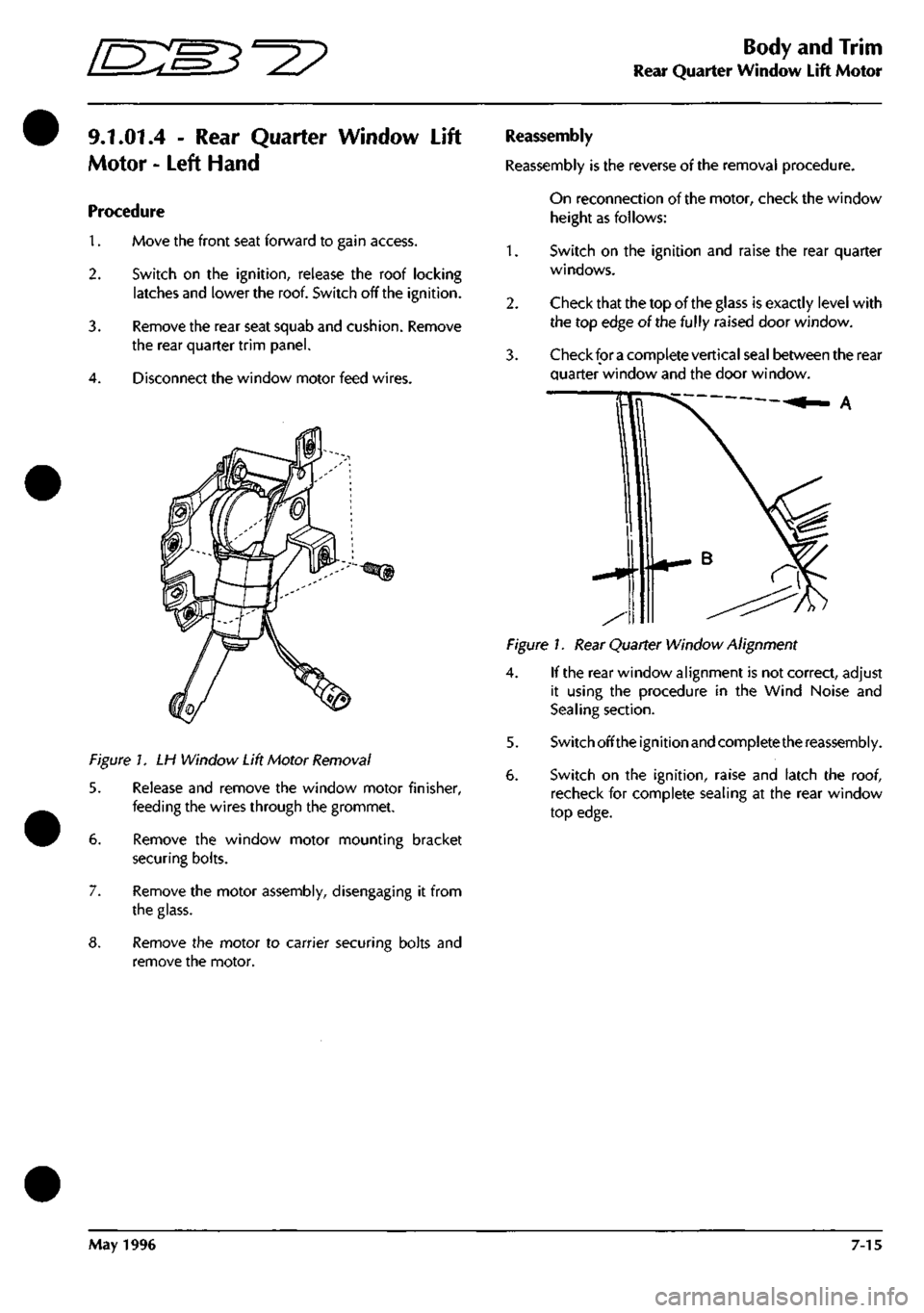
^^7
Body and Trim
Rear Quarter Window Lift Motor
9.1.01.4 - Rear Quarter Window Lift
Motor - Left Hand
Procedure
1.
Move the front seat forward to gain access.
2.
Switch on the ignition, release the roof locking
latches and lower the roof. Switch off the ignition.
Remove the rear seat squab and cushion. Remove
the rear quarter trim panel.
Disconnect the window motor feed wires.
Figure 1. LH Window Lift Motor Removal
5. Release and remove the window motor finisher,
feeding the wires through the grommet.
6. Remove the window motor mounting bracket
securing bolts.
7. Remove the motor assembly, disengaging it from
the glass.
8. Remove the motor to carrier securing bolts and
remove the motor.
Reassembly
Reassembly is the reverse of the removal procedure.
On reconnection of the motor, check the window
height as follows:
1.
2.
Switch on the ignition and raise the rear quarter
windows.
Check that the top of the glass is exactly level with
the top edge of the fully raised door window.
Check for
a
complete vertical seal between the rear
quarter window and the door window.
Figure 1. Rear Quarter Window Alignment
4.
If the rear window alignment is not correct, adjust
it using the procedure in the Wind Noise and
Sealing section.
5. Switch off the ignition and complete the reassembly.
6. Switch on the ignition, raise and latch the roof,
recheck for complete sealing at the rear window
top edge.
May 1996 7-15
Page 271 of 421
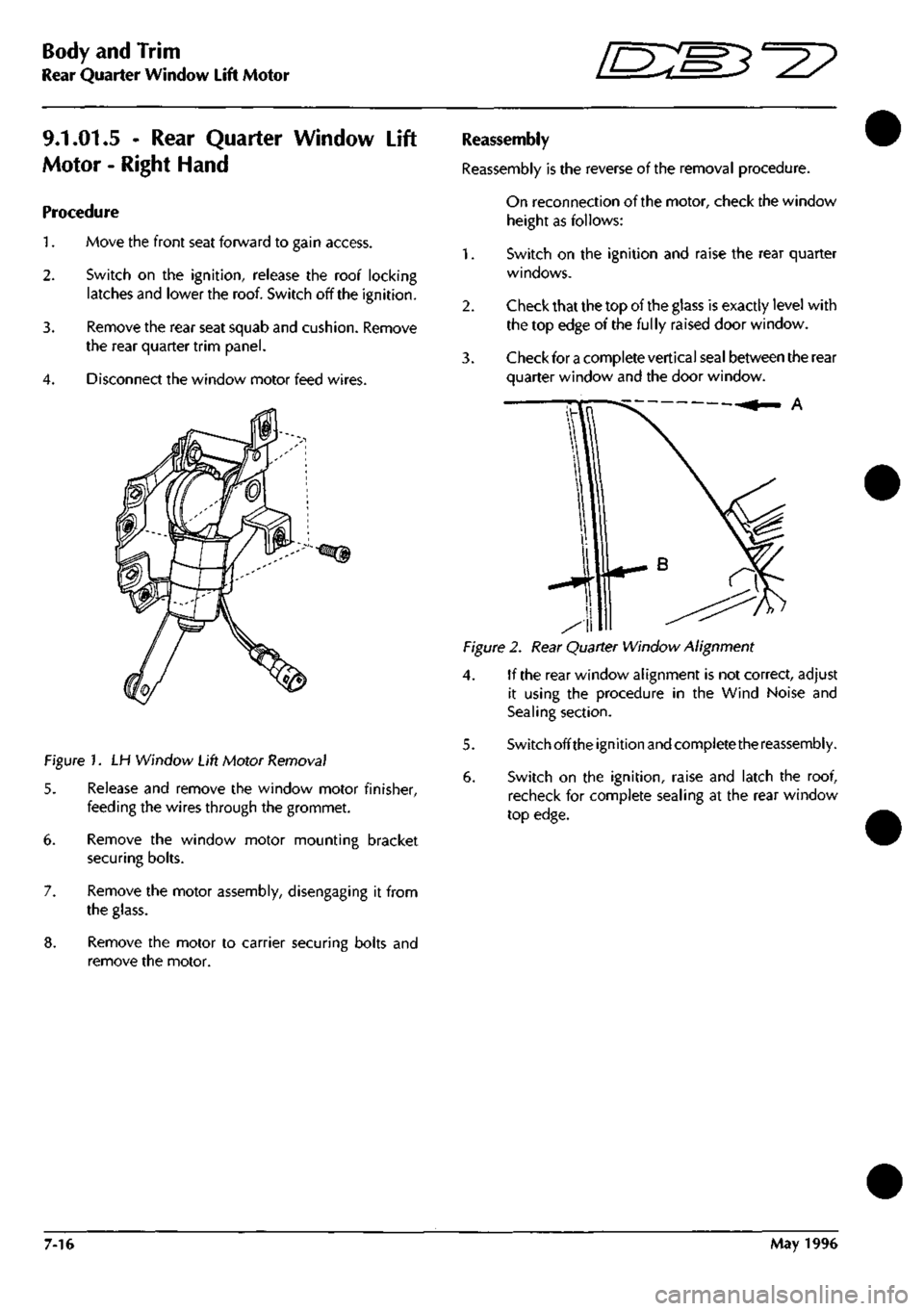
Body and Trim
Rear Quarter Window Lift Motor '^^
9.1.01.5 - Rear Quarter Window Lift
Motor - Right Hand
Procedure
1.
Move the front seat forward to gain access.
2.
Switch on the ignition, release the roof locking
latches and lower the roof. Switch off the ignition.
3. Remove the rear seat squab and cushion. Remove
the rear quarter trim panel.
4.
Disconnect the window motor feed wires.
Figure 1. LH Window Lift Motor Removal
5. Release and remove the window motor finisher,
feeding the wires through the grommet.
6. Remove the window motor mounting bracket
securing bolts.
7. Remove the motor assembly, disengaging it from
the glass.
8. Remove the motor to carrier securing bolts and
remove the motor.
Reassembly
Reassembly is the reverse of the removal procedure.
On reconnection of the motor, check the window
height as follows:
1.
Switch on the ignition and raise the rear quarter
windows.
2.
Check that the top of the glass is exactly level with
the top edge of the fully raised door window.
3. Check for a complete vertical seal between the rear
quarter window and the door window.
A
Figure 2. Rear Quarter Window Alignment
4. If the rear window alignment is not correct, adjust
it using the procedure in the Wind Noise and
Sealing section.
5. Switch offthe ignition and complete the reassembly.
6. Switch on the ignition, raise and latch the roof,
recheck for complete sealing at the rear window
top edge.
7-16 May 1996
Page 272 of 421
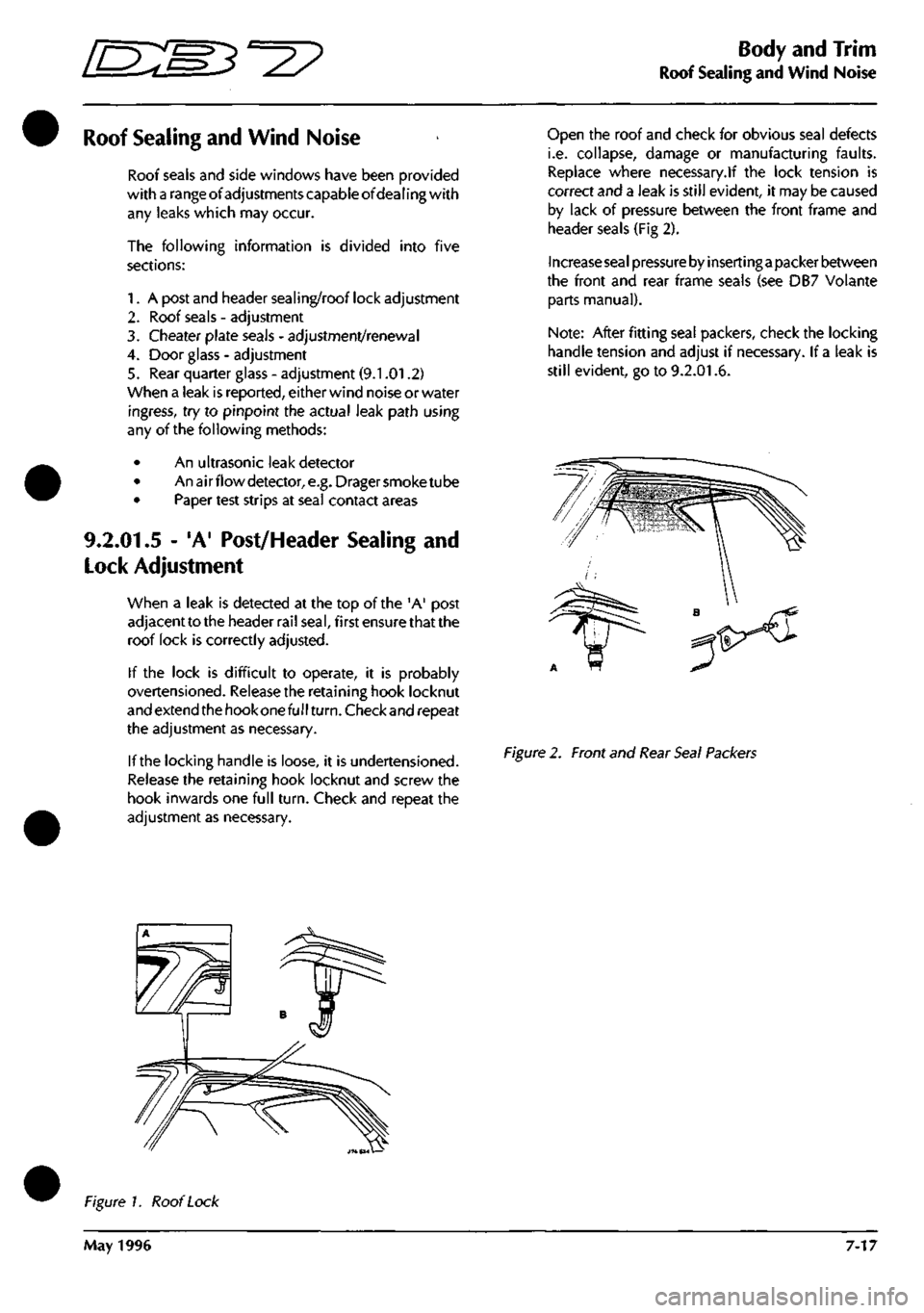
^^2?
Body and Trim
Roof Sealing and Wind Noise
Roof Sealing and Wind Noise
Roof seals and side windows have been provided
with
a range
ofadjustments capable ofdealing with
any leaks which may occur.
The following information is divided into five
sections:
1.
A post and header sealing/roof lock adjustment
2.
Roof seals - adjustment
3. Cheater plate seals - adjustment/renewal
4.
Door glass - adjustment
5. Rear quarter glass - adjustment (9.1.01.2)
When a leak is
reported,
either wind noise or water
ingress, try to pinpoint the actual leak path using
any of the following methods:
• An ultrasonic leak detector
• An air flow
detector,
e.g.
Drager
smoke
tube
• Paper test strips at seal contact areas
9.2.01.5 - 'A' Post/Header Sealing and
Lock Adjustment
when a leak is detected at the top of the 'A' post
adjacent to the header rail
seal,
first
ensure
that the
roof lock is correctly adjusted.
If the lock is difficult to operate, it is probably
overtensioned. Release the retaining hook locknut
and extend
the hook
one full
turn.
Checkand repeat
the adjustment as necessary.
If the locking handle is loose, it is undertensioned.
Release the retaining hook locknut and screw the
hook inwards one full
turn.
Check and repeat the
adjustment as necessary.
Open the roof and check for obvious seal defects
i.e. collapse, damage or manufacturing faults.
Replace where necessary.lf the lock tension is
correct and a leak is still evident, it may be caused
by lack of pressure between the front frame and
header seals (Fig 2).
Increase seal pressure by inserting a
packer between
the front and rear frame seals (see DB7 Volante
parts manual).
Note:
After fitting
sea!
packers, check the locking
handle tension and adjust if necessary. If
a
leak is
still evident, go to 9.2.01.6.
Figure
2. Front and
Rear Seal Packers
Figure 1. Roof
Lock
May 1996 7-17
Page 275 of 421
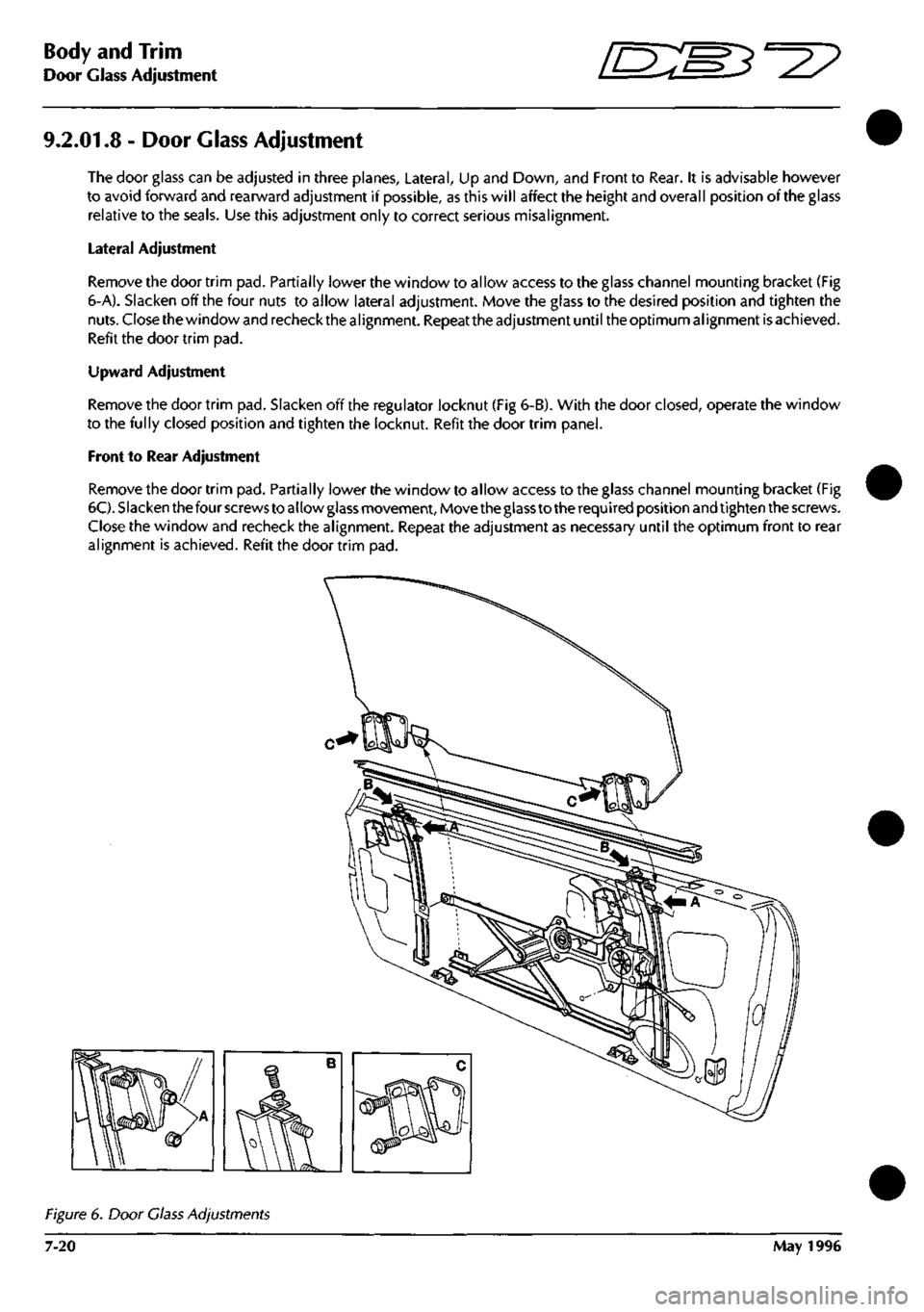
Body and Trim
Door Glass Adjustment ^?
9.2.01.8 - Door Glass Adjustment
The door glass can be adjusted in three planes. Lateral, Up and Down, and Front to Rear. It is advisable however
to avoid forward and rearward adjustment if possible,
as
this will affect the height and overall position of
the
glass
relative to the seals. Use this adjustment only to correct serious misalignment.
Lateral Adjustment
Remove the door trim pad. Partially lower the window to allow access to the glass channel mounting bracket (Fig
6-A). Slacken off the four nuts to allow lateral adjustment. Move the glass to the desired position and tighten the
nuts.
Close the
window
and
recheck the alignment.
Repeat the
adjustment until
the
optimum alignment
is
achieved.
Refit the door trim pad.
Upward Adjustment
Remove the door trim pad. Slacken off the regulator locknut (Fig 6-B). With the door
closed,
operate the window
to the fully closed position and tighten the locknut. Refit the door trim panel.
Front to Rear Adjustment
Remove the door trim pad. Partially lower the window to allow access to the glass channel mounting bracket (Fig
6C).
Slacken
the
four
screws
to allow
glass
movement.
Move
theglass
to the
required position
and tighten
the screws.
Close the window and recheck the alignment. Repeat the adjustment as necessary until the optimum front to rear
alignment is achieved. Refit the door trim pad.
Figure
6. Door
Class Adjustments
7-20 May 1996